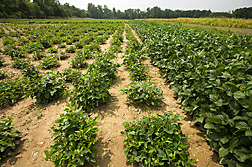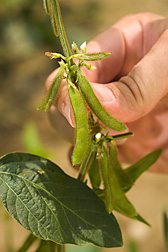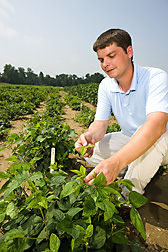Uncorking Genetic Bottlenecks in Soy
Soybeans are second only to corn as America’s most widely grown crop, with nearly 76 million acres planted in 2006. That’s because the nitrogen-fixing legume, which originated in Asia, is incredibly versatile. Edible uses run the gamut from cooking oil and veggie burgers to sashimi and soy sauce; industrial uses range from cosmetics and printing inks to lubricants and biodiesel.
And yet, for all its versatility, soy sits atop a narrow genetic base that, some researchers contend, could leave it vulnerable to exotic new diseases or insect pests—like Aphis glycines, the Asian aphid, which was first detected in Wisconsin in 2000.
Researchers at the ARS Soybean Genomics and Improvement Laboratory (SGIL) in Beltsville, Maryland, are looking for efficient ways to uncork this so-called genetic bottleneck in today’s soybean crop, and they’re using valuable genetic resources preserved at another ARS facility, in Urbana, Illinois.
|
|
Widening the Base
Two events in soybean’s history are thought to have caused the genetic bottleneck: use of only a few introduced precursor beans, called “landraces,” to form the genetic base of the American soybean crop in the mid-20th century and a focus on selectively breeding soybeans for pest resistance, seed-quality traits, and productivity above all else.
Implicit in discussion of the narrow genetic base of a crop species is the suggestion that a wider base would protect the crop from genetic vulnerability. One way to widen the genetic base of U.S. soybeans is to use many more landraces in hopes that they would contain genes to ward off future new diseases or insect pests.
But this approach may not be the most efficient, according to a team of scientists led by SGIL’s David L. Hyten and Perry B. Cregan.
Writing in the November 2006 Proceedings of the National Academy of Sciences, the team contends that, “Given the low frequency of useful variants for a given trait, it is likely that randomly adding 100 new Asian landraces to the elite germplasm pool will only slightly increase useful diversity beyond that already present in the North American elite cultivars.”
A better approach, they propose, is to anticipate an exotic pest’s or pathogen’s arrival by going to the region where it is problematic and seeking out protective genes in tolerant varieties. “Those genes could be incorporated into elite U.S. cultivars with wide adaption, in anticipation of an outbreak in the United States,” Hyten says.
This is where the USDA Soybean Germplasm Collection at Urbana comes in. The collection includes more than 17,000 landraces from Asia and other locations as well as the wild soybean, Glycine soja, which is the progenitor of the modern soybean, Glycine max. The team’s research confirms the value of these critical genetic resources but also shows the importance of being highly selective in their use.
Scoping Out the Genetic Scene
The scientists came to their conclusions based on their determination of the DNA sequences of 102 genes from 4 major groups of soybeans affected: the wild soybean native to Asia, the landraces derived from them by the first Asian farmers, the small number of Asian landraces introduced to America in the 20th century, and the cultivars that resulted from the intensive plant breeding that followed.
“We analyzed the genetic bottleneck resulting from the domestication of soy, which began around 5,000 years ago in Asia,” adds Hyten, a geneticist at the Beltsville lab, where Cregan is research leader. Their collaborators on the published paper were Randall L. Nelson, of the ARS Soybean/Maize Germplasm, Pathology, and Genetics Research Unit, Urbana, Illinois; Randy C. Shoemaker, with ARS’s Corn Insects and Crop Genetics Research Unit, Ames, Iowa; Qijian Song and José Costa, University of Maryland-College Park; James E. Specht, of the University of Nebraska-Lincoln; and visiting scientists Youlin Zhu from China and Ik-Young Choi from Korea.
The soybeans whose sequences they analyzed included 26 accessions, or samples, of G. soja; 52 Asian landraces; 17 landrace founders used to establish today’s $18-billion-plus soy crop, starting in 1947, and 25 elite cultivars used in U.S. soybean production.
Not That Different
After examining variations in the DNA sequences and in alternate gene forms called “alleles,” the researchers concluded that the difference in genetic diversity between today’s beans and their landrace founders was statistically insignificant. But the U.S. beans lacked many of the alleles found in the wild soybeans, which suggests that a significant genetic bottleneck occurred when Asia’s first farmers began domesticating the legume thousands of years ago.
Nonetheless, a “surprising result of the analysis was that genetic bottlenecks associated with the introduction of soybean to North America, followed by intensive selection via plant breeding, had only reduced overall genetic variation by 25 percent, which was much less than first anticipated,” says Hyten. But some rare alleles were lost. Discovering alleles that could improve today’s cultivars will require extensive mining of the germplasm collection.
Numerous published reports document searches for new genes offering pest resistance in soybean. In almost all cases, such protective genes occur in less than 1 percent of USDA’s Asian landrace collection. “So, randomly crossing them with elite bean varieties probably isn’t the best approach to take if one wants to protect the crop from a future pest that has not yet appeared on U.S. farms,” says Hyten.
The beauty of the USDA collection is that it may hold accessions from the pest’s area of origin that harbor a gene or genes for resistance not found in the U.S. crop. That’s why Hyten’s group recommends continued maintenance and characterization of the collection’s accessions. They are a starting point in times of need.
Hand in hand with that is keeping a diligent watch on pest problems as they occur in other parts of the world. That way, if nothing is available in the USDA collection, the researchers know where else to search for new sources of resistance. The team also recommends stocking up on wild soybeans as allelic sources that can be mined for their genetic diversity.—By Jan Suszkiw, Agricultural Research Service Information Staff.
This research is part of Plant Genetic Resources, Genomics, and Genetic Improvement, an ARS national program (#301) described on the World Wide Web at www.nps.ars.usda.gov.
To reach scientists mentioned in this story, contact Jan Suszkiw, USDA-ARS Information Staff, 5601 Sunnyside Ave., Beltsville, MD 20705-5129; phone (301) 504-1630, fax (301) 504-1486.
"Uncorking Genetic Bottlenecks in Soy" was published in the November/December 2007 issue of Agricultural Research magazine.









